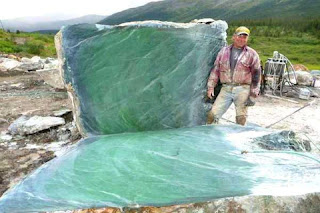A colossal boulder of Nephrite Jade has been unearthed in Canada
Mining nephrite in British Columbia poses significant challenges due to the province's harsh winters characterized by prolonged and extreme cold conditions. The nephrite deposits are situated in remote locations, limiting mining activities to the relatively short summer season, which spans approximately 60 days each year.
Nephrite deposits vary in size, ranging from 12 inches to 12 feet in width. Quarrying operations face considerable challenges when dealing with the wider jade deposits. Surface nephrite boulders can sometimes exceed weights of approximately 200 tons and are seldom lighter than 100 pounds. However, Jade West endeavors to maintain the overall weight of its nephrite boulders at around five tons, a manageable size for mining, handling, and transportation via trucks to the nearest town, located roughly 100 miles away. The typical weight of nephrite averages around two tons, a size that meets the requirements of most carving factories in China.
Although jade and agate are commonly perceived as separate minerals, they belong to the same mineral family called the chalcedony group. Both stones comprise tiny crystals of quartz that have undergone compression over time, leading to the formation of a dense, resilient stone cherished for its aesthetic appeal and strength.
Although jade is commonly linked with green hues and agate with striped patterns and a broader spectrum of colors, both stones can exhibit significant variations in color and appearance based on the particular minerals and impurities within their composition. Furthermore, both jade and agate are thought to harbor potent healing attributes, which contribute to their popularity in crystal healing and energy practices.




Comments
Post a Comment